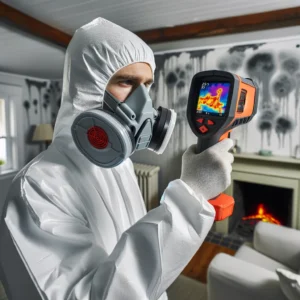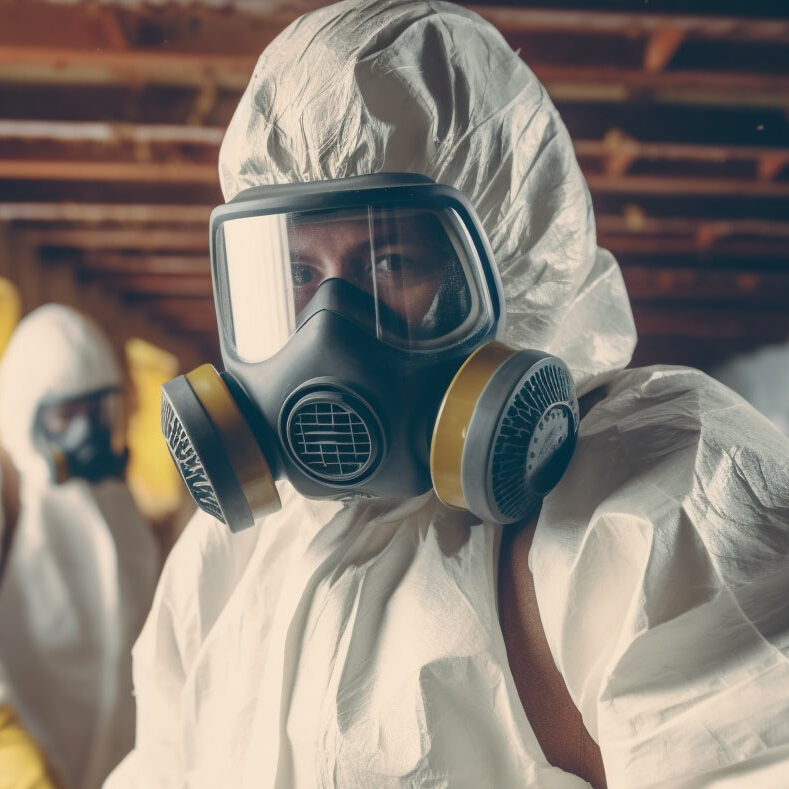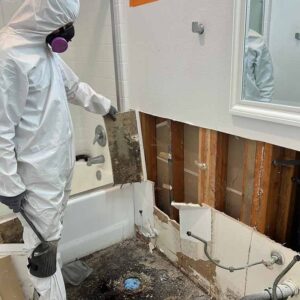Welcome to our blog on mold inspection and remediation. In this article, we will delve into the basics of mold, the importance of mold inspection, the difference between mold testing and inspection, the cost factors involved, the steps to take after a mold inspection, preventive measures against mold growth, and why timely mold inspection and remediation matter. Whether you are a property owner, a new home buyer, or simply interested in learning more about mold, this guide will provide you with the essential information you need to know. So, let’s get started and explore the world of mold inspection and remediation.
Understanding Mold: A Hazardous Growth
When it comes to mold, it is important to understand the potential hazards associated with its growth. Mold is a type of fungus that thrives in moist environments, often appearing as fuzzy patches on surfaces. While mold is a natural part of our environment, indoor mold growth can lead to health concerns and compromise indoor air quality. The presence of mold spores, which are microscopic in size, can trigger allergic reactions, asthma, and respiratory issues when inhaled. It is crucial to address mold growth promptly to maintain a healthy living environment.
What is Mold?
Mold is a common type of fungus that can be found both indoors and outdoors. It reproduces by releasing tiny, lightweight spores that can travel through the air. When mold spores land on surfaces with enough moisture, they can germinate and begin to grow. Mold growth is commonly observed on porous materials, such as carpets, wood, insulation, and drywall, that provide a suitable environment for mold to thrive. These materials can retain moisture, creating an ideal breeding ground for mold colonies. To prevent mold growth, it is important to address any moisture problems in your home or building.
Why is Mold a Concern?
Mold can have a significant impact on indoor air quality, leading to various health effects. When mold spores are present in the air, they can be inhaled, causing allergic reactions, respiratory issues, and other health concerns, especially in individuals with pre-existing conditions such as asthma or allergies. Additionally, mold growth can damage building materials, compromising the structural integrity of your property. Water damage, whether from leaks, floods, or high humidity, can create an environment conducive to mold growth. It’s essential to address mold problems promptly to ensure a safe and healthy indoor environment.
The Importance of Mold Inspection
Ensuring Clean Air: Mold inspection is critical for maintaining a healthy environment. It’s also a good idea to regularly inspect homes in Southern California, including Temecula Valley and French Valley. Scrubbing mold from old town properties is necessary for a mold-free living space.
When Should you Consider a Mold Inspection?
Consider a mold inspection when there are visible signs of mold growth, water damage, or mold spores. It’s crucial after water restoration or moisture control. New home buyers should also consider it to address potential mold problems. After any significant water problems like leaks or flooding, a mold inspection is essential.
What Happens During a Mold Inspection?
During a mold inspection, professionals assess the extent of mold damage and growth. They examine building materials, indoor air quality, and the presence of mold spores. The remediation process starts with a thorough mold inspection to understand the scope of the problem, including specific areas like the HVAC system and porous materials.

Mold Testing Vs Mold Inspection: What’s the Difference?
Mold Testing Vs Mold Inspection: What’s the Difference?
When it comes to mold remediation, understanding the difference between mold testing and mold inspection is crucial. Mold testing involves taking samples to determine the type and concentration of mold present in a space. On the other hand, mold inspection involves a thorough assessment of the property to identify any signs of mold growth and assess the extent of the problem. Both processes play a vital role in determining the best course of action for effective mold remediation.
The Role of Air Quality Testing in Mold Detection
Detecting mold spores, assessing indoor air quality, and identifying mold contamination are aided by air quality testing. It helps determine the presence of mold, moisture, and any related health concerns. Effective mold detection relies on air quality testing, especially in areas prone to mold contamination.
Interpreting Mold Testing Results
Understanding mold spore presence, moisture levels, and indoor air quality is essential for interpreting mold testing results. Accurate interpretation guides the cleanup process, helping property owners effectively address mold problems and assess contamination extent.
The Cost Factor in Mold Inspection
Understanding the financial considerations of mold inspection. Factors influencing cost such as the size of the affected area and the extent of the damage. Additional expenses for specialized inspections or sampling outside of the standard assessment.
Factors Affecting the Cost of Mold Inspection
Factors impacting the expense of mold inspection include the area size for inspection, property type (residential/commercial), severity of mold growth, location accessibility, and potential health concerns.
Tips to Find an Affordable Yet Reliable Mold Inspector
When seeking a mold inspector, ask for referrals from trusted sources like friends, family, or industry professionals. Verify the inspector’s certifications and qualifications for reliability. Obtain quotes from different inspection companies and research customer reviews for quality assessment.
Steps After the Mold Inspection
After a thorough mold inspection, it’s essential to clean mold immediately. In Temecula Valley, Southern California, contacting professionals is a good idea for effective remediation. With square feet in consideration, scrub mold from surfaces using appropriate methods and products.
Understanding the Mold Inspection Report
The inspection report must provide details on the location, extent, and type of mold growth discovered, along with recommendations for remediation and moisture control. Additionally, it should outline any health concerns related to mold contamination and include photographic evidence of the mold growth and damage.
Choosing the Right Remediation Process based on Inspection
When choosing a remediation process, it’s crucial to consider the extent of mold contamination and evaluate any structural damage caused by its growth. Addressing underlying moisture issues is essential to prevent a recurrence, prioritizing the health and safety of occupants.
Delving into Mold Remediation
Key Components of Mold Remediation:
Addressing mold in united states, especially southern california, involves thorough inspection and clean mold removal. Whether in wine country or city of temecula, scrub mold from every corner, ensuring a mold-free environment.
An Overview of the Mold Remediation Process
The remediation initiates with a comprehensive evaluation and strategy by certified experts. Containment barriers are set up to isolate the affected areas. HEPA filtration captures airborne spores, while post-cleanup testing confirms mold removal. Repairing or replacing damaged materials may be necessary.
Safety Measures During Mold Remediation
During mold remediation, workers must use personal protective equipment like respirators and gloves. Adequate ventilation and air filtration are crucial to minimize exposure to airborne mold spores. Regular indoor air quality monitoring ensures a safe working environment. Compliance with environmental regulations and proper disposal of mold-contaminated materials is essential.
Preventive Measures Against Mold Growth
Utilize preventive measures to avoid mold growth. Regularly inspect and clean mold-prone areas in your home. Properly ventilate and dehumidify damp spaces to prevent mold formation. Consider professional mold remediation for larger areas.
Effective Strategies for Mold-Proofing Your Home
To prevent mold growth, seal entry points for moisture and maintain indoor humidity below 60%. Regularly inspect and repair water sources, clean gutters, and consider professional mold testing.
Maintenance Tips to Keep Mold at Bay
Regularly cleaning and drying water-damaged areas promptly is essential. Utilize mold-resistant products for building materials to prevent growth. Maintain indoor humidity levels below 60% and ensure proper ventilation in moisture-prone areas like bathrooms and kitchens. Promptly repair leaks in the roof, walls, or plumbing.
The Role of Professional Cleaning in Mold Prevention
Specialized equipment is used to detect hidden mold, following industry standards for testing and remediation. Thorough mold removal and addressing the root cause of growth are ensured by professional cleaning. Recommendations for preventing future mold problems are provided.
“Can Regular Ventilation and Dehumidification Prevent Mold Growth?”
Regular ventilation and dehumidification play a crucial role in preventing mold growth. By reducing moisture levels and controlling indoor humidity, these practices inhibit mold proliferation. Consistent air circulation and efficient ventilation systems also support indoor air quality and help mitigate moisture-related issues.
Why Timely Mold Inspection and Remediation Matters?
Ensuring timely mold inspection and remediation is crucial for several reasons. It prevents the spread of mold, reduces health concerns associated with mold exposure, minimizes damage to property, saves time and cost, and safeguards indoor air quality.
Connect with your Temecula experts
Expert assessment ensures thorough mold presence evaluation. Professional remediation mitigates health effects. Temecula experts offer guidance, testing, cleanup, and tailored recommendations for mold removal.
Conclusion
In conclusion, mold inspection and remediation are crucial for maintaining a safe and healthy environment. Mold can pose serious health risks and cause structural damage to your home. By conducting regular inspections, you can identify and address mold issues before they become severe. The cost of mold inspection may vary depending on factors such as the size of your property and the extent of the mold problem. It’s important to choose a reliable and affordable mold inspector who can provide accurate testing results and recommendations for remediation. Taking preventive measures such as proper ventilation, dehumidification, and regular maintenance can help prevent mold growth in the future. Remember, timely mold inspection and remediation is key to ensuring the well-being of your home and your loved ones. If you’re in Temecula, connect with our experts for professional assistance and guidance.







